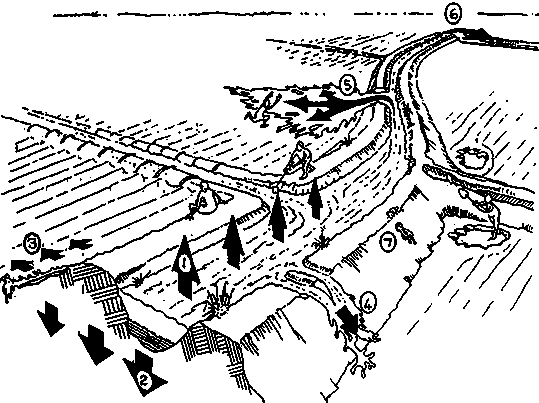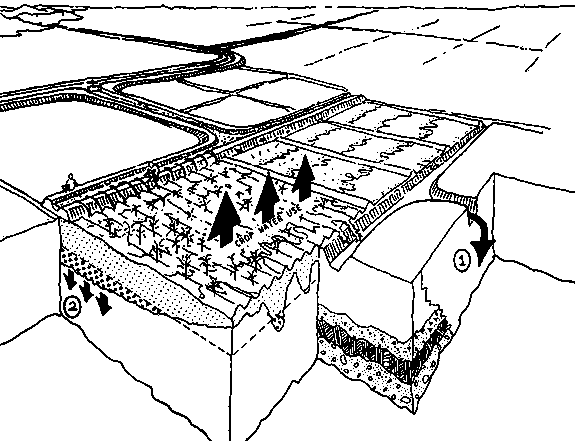Not all water taken from a source (river, well) reaches the root zone of the plants. Part of the water is lost during transport through the canals and in the fields. The remaining part is stored in the root zone and eventually used by the plants. In other words, only part of the water is used efficiently, the rest of the water is lost for the crops on the fields that were to be irrigated.
Figure 24 shows the irrigation water losses in canals; these are due to:
1. Evaporation from the water surface
2. Deep percolation to soil layers underneath the canals
3. Seepage through the bunds of the canals
4. Overtopping the bunds
5. Bund breaks
6. Runoff in the drain
7. Rat holes in the canal bunds
Figure 24. Irrigation water losses in canals

Figure 25 shows the irrigation water losses in the field; these are due to:
1. Surface runoff, whereby water ends up in the drain
2. Deep percolation to soil layers below the root zone
Figure 25. Irrigation water losses in the field

To express which percentage of irrigation water is used efficiently and which percentage is lost, the term irrigation efficiency is used.
The scheme irrigation efficiency (e in %) is that part of the water pumped or diverted through the scheme inlet which is used effectively by the plants. The scheme irrigation efficiency can be sub-divided into:
- the conveyance efficiency (ec) which represents the efficiency of water transport in canals, and- the field application efficiency (ea) which represents the efficiency of water application in the field.
The conveyance efficiency (ec) mainly depends on the length of the canals, the soil type or permeability of the canal banks and the condition of the canals.
In large irrigation schemes more water is lost than in small schemes, due to a longer canal system. From canals in sandy soils more water is lost than from canals in heavy clay soils. When canals are lined with bricks, plastic or concrete, only very little water is lost. If canals are badly maintained, bund breaks are not repaired properly and rats dig holes, a lot of water is lost.
Table 7 provides some indicative values of the conveyance efficiency (ec), considering the length of the canals and the soil type in which the canals are dug. The level of maintenance is not taken into consideration: bad maintenance may lower the values of Table 7 by as much as 50%.
Table 7. INDICATIVE VALUES OF THE CONVEYANCE EFFICIENCY (ec) FOR ADEQUATELY MAINTAINED CANALS
|
|
Earthen canals |
Lined canals |
||
|
Soil type |
Sand |
Loam |
Clay |
|
|
Canal length |
|
|
|
|
|
Long (> 2000m) |
60% |
70% |
80% |
95% |
|
Medium (200-2000m) |
70% |
75% |
85% |
95% |
|
Short (< 200m) |
80% |
85% |
90% |
95% |
The field application efficiency (ea) mainly depends on the irrigation method and the level of farmer discipline. Some indicative values of the average field application efficiency (ea) are given in Table 8. Lack of discipline may lower the values found in Table 8.
Table 8. INDICATIVE VALUES OF THE FIELD APPLICATION EFFICIENCY (ea)
|
Irrigation methods |
Field application efficiency |
|
Surface irrigation (border, furrow, basin) |
60% |
|
Sprinkler irrigation |
75% |
|
Drip irrigation |
90% |
Once the conveyance and field application efficiency have been determined, the scheme irrigation efficiency (e) can be calculated, using the following formula:

with
e = scheme irrigation efficiency (%)
ec = conveyance efficiency (%)
ea = field application efficiency (%)
A scheme irrigation efficiency of 50-60% is good; 40% is reasonable, while a scheme Irrigation efficiency of 20-30% is poor.
It should be kept in mind that the values mentioned above are only indicative values.
EXAMPLE
QUESTION:
Determine the project irrigation efficiency for a scheme with a long canal system. The canals are constructed in heavy clay and the irrigation method is furrow irrigation. Maintenance of the canals is adequate.
ANSWER:
Estimate the conveyance efficiency, using Table 7: ec = 80%.
Determine the field application efficiency, using Table 8: ea = 60%.
Calculate the scheme irrigation efficiency, using the formula: 
Thus, the scheme irrigation efficiency e = 80 x 60/100 = 48% or approximately 50%. This is considered a fairly good scheme Irrigation efficiency, for a surface Irrigation system.